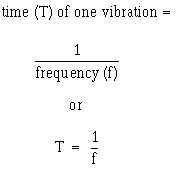1-10
Figure 1-8.—Longitudinal wave represented graphically by a transverse wave.
The frequency of a longitudinal wave, like that of a transverse wave, is the number of complete
cycles the wave makes during a specific unit of time. The higher the frequency, the greater is the number
of compressions and expansions per unit of time.
In the two types of wave motion described in the preceding discussion, the following quantities are
of interest:
a. The PERIOD, which is the time (T) in which one complete vibratory cycle of events occurs,
b. The FREQUENCY OF VIBRATION (f), which is the number of cycles taking place in one
second, and
c. The WAVELENGTH, which is the distance the disturbance travels during one period of
vibration.
Now, consider the following concept. If a vibrating object makes a certain number of vibrations per
second, then 1 second divided by the number of vibrations is equal to the period of time of 1 vibration. In
other words, the period, or time, of 1 vibration is the reciprocal of the frequency; thus,
If you know the velocity of a wave, you can determine the wavelength by dividing the velocity by
the frequency. As an equation:





